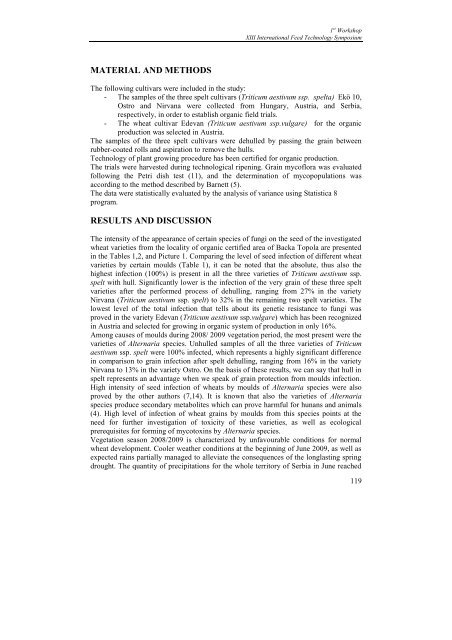Effects of dietary n-3 polyunsaturated fatty acids and ... - FINS
Effects of dietary n-3 polyunsaturated fatty acids and ... - FINS
Effects of dietary n-3 polyunsaturated fatty acids and ... - FINS
Create successful ePaper yourself
Turn your PDF publications into a flip-book with our unique Google optimized e-Paper software.
1 st WorkshopXIII International Feed Technology SymposiumMATERIAL AND METHODSThe following cultivars were included in the study:- The samples <strong>of</strong> the three spelt cultivars (Triticum aestivum ssp. spelta) Ekö 10,Ostro <strong>and</strong> Nirvana were collected from Hungary, Austria, <strong>and</strong> Serbia,respectively, in order to establish organic field trials.- The wheat cultivar Edevan (Triticum aestivum ssp.vulgare) for the organicproduction was selected in Austria.The samples <strong>of</strong> the three spelt cultivars were dehulled by passing the grain betweenrubber-coated rolls <strong>and</strong> aspiration to remove the hulls.Technology <strong>of</strong> plant growing procedure has been certified for organic production.The trials were harvested during technological ripening. Grain myc<strong>of</strong>lora was evaluatedfollowing the Petri dish test (11), <strong>and</strong> the determination <strong>of</strong> mycopopulations wasaccording to the method described by Barnett (5).The data were statistically evaluated by the analysis <strong>of</strong> variance using Statistica 8program.RESULTS AND DISCUSSIONThe intensity <strong>of</strong> the appearance <strong>of</strong> certain species <strong>of</strong> fungi on the seed <strong>of</strong> the investigatedwheat varieties from the locality <strong>of</strong> organic certified area <strong>of</strong> Backa Topola are presentedin the Tables 1,2, <strong>and</strong> Picture 1. Comparing the level <strong>of</strong> seed infection <strong>of</strong> different wheatvarieties by certain moulds (Table 1), it can be noted that the absolute, thus also thehighest infection (100%) is present in all the three varieties <strong>of</strong> Triticum aestivum ssp.spelt with hull. Significantly lower is the infection <strong>of</strong> the very grain <strong>of</strong> these three speltvarieties after the performed process <strong>of</strong> dehulling, ranging from 27% in the varietyNirvana (Triticum aestivum ssp. spelt) to 32% in the remaining two spelt varieties. Thelowest level <strong>of</strong> the total infection that tells about its genetic resistance to fungi wasproved in the variety Edevan (Triticum aestivum ssp.vulgare) which has been recognizedin Austria <strong>and</strong> selected for growing in organic system <strong>of</strong> production in only 16%.Among causes <strong>of</strong> moulds during 2008/ 2009 vegetation period, the most present were thevarieties <strong>of</strong> Alternaria species. Unhulled samples <strong>of</strong> all the three varieties <strong>of</strong> Triticumaestivum ssp. spelt were 100% infected, which represents a highly significant differencein comparison to grain infection after spelt dehulling, ranging from 16% in the varietyNirvana to 13% in the variety Ostro. On the basis <strong>of</strong> these results, we can say that hull inspelt represents an advantage when we speak <strong>of</strong> grain protection from moulds infection.High intensity <strong>of</strong> seed infection <strong>of</strong> wheats by moulds <strong>of</strong> Alternaria species were alsoproved by the other authors (7,14). It is known that also the varieties <strong>of</strong> Alternariaspecies produce secondary metabolites which can prove harmful for hunans <strong>and</strong> animals(4). High level <strong>of</strong> infection <strong>of</strong> wheat grains by moulds from this species points at theneed for further investigation <strong>of</strong> toxicity <strong>of</strong> these varieties, as well as ecologicalprerequisites for forming <strong>of</strong> mycotoxins by Alternaria species.Vegetation season 2008/2009 is characterized by unfavourable conditions for normalwheat development. Cooler weather conditions at the beginning <strong>of</strong> June 2009, as well asexpected rains partially managed to alleviate the consequences <strong>of</strong> the longlasting springdrought. The quantity <strong>of</strong> precipitations for the whole territory <strong>of</strong> Serbia in June reached119
















